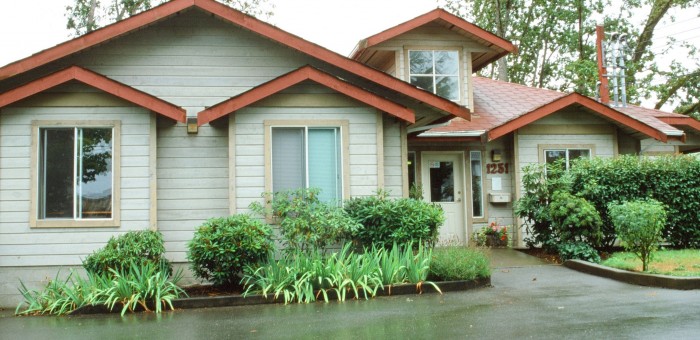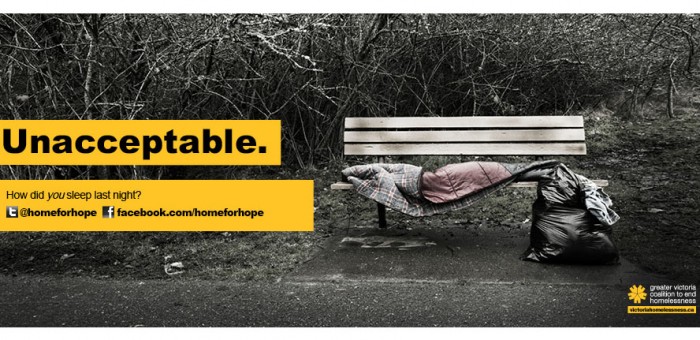Sharing Stories
Sharing Stories: Mustard Seed — Poverty and Food Insecurity
In our most recent post in our series on poverty and homelessness we asked people to consider sharing a story about their experiences. Sharing these stories serves as a reminder that poverty and homelessness are not a choice. It’s important for us to end the stigma and stereotypes that are too often associated with these issues. Each of us has followed a different path from the past to the present. Yet some of our paths have been rockier than others.
This week we are pleased to offer the third of these stories. We are grateful to The Mustard Seed for providing it to us. Entering into its 40th year of operation, the Mustard Seed is a non-profit organization providing many crucial services to those in need.
This post looks at the shift of non-profit food in Victoria, highlighting the connection between food provision and supportive programing, and the emergence of the Greater Victoria Food Share Network.
Food insecurity: The state of being without reliable access to sufficient quantity of affordable, nutritious and culturally appropriate food.
Food insecurity is one of several issues facing low-income communities in Greater Victoria, constituting one of the many facets of poverty that The Mustard Seed is working to eliminate. Through the creation of a micro food system within the organization through the production and distribution of food, followed by the composting of organic waste, The Mustard Seed does food banking well.
Our Drug and Alcohol Recovery Program at Hope Farm Healing Centre produces local, organic and fresh foods such as produce, eggs, and meat products that local businesses and non-profits purchase. Those in the program are supported in their recovery through the reconnection to land and to their food through farm work and the harvest season. Our food bank then distributes that fresh food along with all the other fresh and non-perishable foods we purchase or receive through amazing donations.
But it’s not enough to grow and distribute food when engaging with the all the complexity of poverty. The provision of food is not enough to say, find someone a place to live or help someone find suitable employment. Food helps, but it’s not enough. How do we do food banks differently in Victoria to engage positively with all the facets of poverty? How do we move away from that “Band-Aid” and emergency service, to food provision that also somehow helps someone find an affordable place to live? Or receive additional training or education to get a suitable job? How can we as food banks help those who come for support start making those positive steps out of the cycle of poverty and achieve food sovereignty?
Food banks were never set up to do this. They were a “stop-gap” with a sunset clause, meaning they were to close when food insecurity was solved. So far food insecurity persists. So as non-profits with mission statements about breaking the cycle of poverty we need to socially advocate for more government investment into long-term solutions like affordable housing, but also innovate on traditional ways of “doing” food banking to start reducing and eliminating poverty. Food banks can’t do this on their own and there is so much that needs to happen to achieve this, but here in Victoria something is shifting. Creative steps are being taken towards breaking the cycle, and to achieving food sovereignty. It’s happening through honest dialogue, collaboration, creativity and hard work.
The emerging of the Greater Victoria Food Share Network, a collaborative group of non-profits to which The Mustard Seed is a member, are moving away from traditional ways of “doing” food banks, steadily shifting away from the “emergency food” model, to one that connects food insecure individuals to their local neighborhood houses, community centres and non-profits, all of whom have supportive programing that food banks don’t. Further, food banks need to innovate better supportive programing on site addressing the root causes of poverty, like the Mustard Seed’s Family Centre focussed on skills training and capacity building for parents.
The connection of food provision and supportive programming, both going hand in hand, is transitioning from 7000-8000 people all heading down to the local food bank to line-up for food, to folks walking across the local park in their own neighborhood to collect an increasingly healthy and nutritious food hamper. Then they are provided with opportunities to participate in programs such as skills training, child care, employment programs and information on access to more affordable housing.
This is one of many collaborative initiatives of the Network and one small step towards a newly emerging way of “doing” food banks or perhaps more appropriately called “food access” in Greater Victoria. It’s not just about giving out food. It’s about the provision of healthy and nutritious food that creates connection. That creates opportunities. That’s done with dignity and respect. And most importantly that breaks the cycle of poverty. Because if we’re not doing that, then we’ll always have food banks. And who wants those?
Sharing Stories: Cridge Centre for the Family — A Story of Hope
In our most recent post in our series on poverty and homelessness we asked people to consider sharing a story about their experiences. Sharing these stories serves as a reminder that poverty and homelessness are not a choice. It’s important for us to end the stigma and stereotypes that are too often associated with these issues. Those who are homeless, just as those who are housed, should not be defined by where they live. Each of us has followed a different path from the past to the present. Yet some of our paths have been rockier than others.
This week we are pleased to offer the second these stories. We are grateful to The Cridge Centre for the Family for providing it to us. The Cridge Centre for the Family has been providing brain injury services for almost 25 years with a commitment to providing supportive housing for survivors of brain injury in Greater Victoria.
Recent studies have offered insight into a possible connection between brain injuries and homelessness, with 53% of the Toronto homeless population found to be living with a traumatic brain injury. The following is an impact story about how the Cridge services have helped a local man overcome the challenges of living with a brain injury.
Surviving a Brain Injury May Be Challenging but There is Hope
DF is 47 year-old male living with a brain injury. He was incarcerated on and off for a total of 14 years. DF’s life has been fraught with addiction issues and his crimes were in support of those addictions. His life was not easy and he makes no excuses for his past; however, he has remorse and regret. Every day he works a little bit harder to make amends and to do good in the community.
DF was homeless and living in a shelter for two years during his parole. In 2012, DF was accepted into Mary Cridge Manor (MCM). MCM is a program within the Brain Injury Services of the Cridge Centre for the Family. It is a housing program where clients live independently with supports. Although nervous, DF was excited for the opportunity to live in an apartment. He had not had a home in five years when he came to live at MCM. When DF moved in, he was so proud of his apartment and how it looked that he didn’t want to go out. He found great pleasure in staying home and knowing that he was safe and in an environment where he could finally thrive.
DF is completing his third year at MCM, which is the maximum time a person can be in the program. During this time, DF committed to developing life skills, interpersonal skills, leisure planning, vocation and addressing his addiction issues. It has not been an easy road but he certainly has tackled each step with courage and determination.
DF felt little hope until moving into this program. Not only is he preparing to move from MCM, he has returned to school and recertified in first-aid and trained in maintenance so he can now seek meaningful employment. He is excited about his future for the first time in many years, and so are we!
Sharing Stories: Threshold Housing Society — Mitchell House 2014
In our most recent post in our series on poverty and homelessness we asked people to consider sharing a story about their experiences. Sharing these stories serves as a reminder that poverty and homelessness are not a choice. It’s important for us to end the stigma and stereotypes that are too often associated with these issues. Those who are homeless, just as those who are housed, should not be defined by where they live. Each of us has followed a different path from the past to the present. Yet some of our paths have been rockier than others.
This week we are pleased to offer the first of these stories. We are grateful to the Threshold Housing Society for providing it to us . The Threshold Housing Society provides transitional housing to youth at risk of becoming homeless.
Threshold Housing Society: Mitchell House 2014
By: Graham Kelly – House Supervisor
It was the night before Christmas, and all through the Scots Motel, many creatures were stirring: not only the mice. Skinny teenager Miles Winter was stirring also, or rather tossing and turning sleeplessly. The motel’s roaches were the worst when you felt them on your face, but at least they were silent. It was the scurrying sound of the mice that actually kept Miles awake, even on Christmas Eve, when everyone was supposed to be in a deep sleep dreaming of all they’d be waking up to. Miles knew there wouldn’t be much to wake up to in a few restless hours, when the sound of the motel alarm clock would go off like every morning, and his dad would plug in their tiny plastic tree and say “Merry Christmas kiddo.” It would not be his best, nor would it be his worst Christmas — so long as it was just the scuffling sound inside the walls, and not the rising sound of fighting through them, or the approaching sound of sirens after that. Lying uncomfortably in a pull-out cot, Miles thought of his little cousins a city away, who would wonder how Santa could get down into a motel room without a chimney, and where you would hang stockings when there was no fireplace – only an old, dead heater.
As he finally drifted off to sleep he hoped his cousins were having a Christmas like the one good one Miles had ever known, the one time the family was together and he got the toy he wanted. And he hoped his own Christmases would get better, be happier, and be in a nice house instead of an old motel.
**** **** ****
But the following Christmas, things looked no better for Miles. He and his dad had fled the infestation of that motel and moved on to another, staying as long as it took for his dad to be accepted into low income housing. The place his dad moved into did not have room for Miles, and he was forced to sleep on friends’ couches, until the welcomes finally wore out. He thought he might have to brave the cold and set up a borrowed tent in the park, spending Christmas outside, all alone. But exactly one week before Christmas Eve last year, everything changed. Miles was accepted on an emergency basis into
Mitchell House, the home for young men that I run. On the night of our Christmas dinner last year, Miles arrived to meet other residents and members of the Threshold Housing ‘family’. He was cold and thin, but excited to start a new life with us – well, right after eating a plate piled high with turkey and stuffing.
**** **** ****
This week, Miles and I went Christmas shopping together. We went straight to the toy aisle, where for a moment Miles seemed to become a child again, challenging me to a duel with a telescoping light sabres.
I noticed how much he has grown in a year, how much stronger he is after learning to cook for himself, and how physically fit he is from his job prepping food for sports events. I see the new clarity in his eyes, the focus and motivation he has gained, as he moves closer to his dream of becoming a chef. I see a strong, gifted, caring young man who has survived and thrived after being given a foundation to build on, and who now wishes to give back. And as he picks out toys to give his young cousins on Christmas morning, I see a young man who will never go back, and will make the world better as he goes forward.
– For every youth like Miles that is accepted, Threshold Housing has to turn away four more –
Cost Savings of Housing-First
“spending $10 on housing and supports for chronically homeless individuals
with the highest needs, result[s] in $21.72 in savings related to health care,
social supports, housing and involvement in the justice system”
The Homeless Hub
Public Opinion on Homelessness
I’ve used the phrase “hidden homelessness” a couple times throughout this series. It is a term that my team and I started using as we began to realise the amount of poverty and homelessness that goes unseen throughout Greater Victoria.
Last month I once more met with Andrew Wynn-Williams, the Executive Director of the Greater Victoria Coalition to End Homelessness, to get an update on the current status of homelessness in our region. As part of the update, Andrew informed me of their recent survey looking at public attitudes towards homelessness.
The survey provided some optimistic findings with regards to public opinion on housing first strategies. For example, 70% of people agreed that providing an individual with housing is cheaper than the costs of homelessness on government services, 90% agreed affordable housing would help reduce homelessness and 85% agreed that ensuring access to affordable housing is the government’s responsibility.
However, I was shocked to read that nearly half of the residents surveyed in Sidney and the Western Communities, and a third of those in Saanich, Oak Bay, Victoria and Esquimalt, did not think that homelessness was an issue in their communities.
While this was a disheartening revelation, I remain optimistic as their seems to be clear public support for the importance of housing initiatives.
Backing public opinion, a number of studies have been released highlighting the benefits of a housing-first strategy for ending homelessness.
Cost-Benefits of Ending Homelessness
Both national and international research has shown the extent of the possible cost-savings associated with shifting our energy from trying to manage homelessness through the provision of emergency services, to actually trying to end homelessness through a housing-first approach. A recent national report from the Canadian Alliance to End Homelessness concluded that spending an extra $46 per Canadian a year on affordable housing could dramatically reduce homelessness, and in turn reduce the $7 billion per year cost of homelessness on our economy.
To find evidence to back these claims up, we need look no further than some of our southern neighbour states. In 2005, Utah launched a homelessness reduction strategy after it was estimated that by housing the chronically homeless the state could save an average of $8,000 per person on costs such as emergency room visits and jail stays. As of 2014, the program has reduced chronic homelessness in Utah by 72%.
While direct data on the overall net savings of the program is not yet available, a similar pilot project in Denver, Colorado found significant savings. For example, total emergency related costs among project participants declined by 72.95% in two years (an average savings of $31,545 per participant), incarceration days and costs were reduced by 76% and emergency shelter costs alone were reduced by an average of $13,600 per person.
Along these same lines, the Mental Health Commission of Canada (MHCC) recently released the findings from their At Home/Chez Soi study. With projects established in five cities, including Vancouver, Winnipeg, Toronto, Montreal and Moncton, the study showed that not only can a Housing-First approach be effectively implemented in Canadian cities of varying size and ethno-racial and cultural composition, but it can also provide overall economic cost-savings while rapidly reducing rates of homelessness. This is especially true among the chronically homeless, where for every $10 invested in housing first services there was an average savings of $21.72.
Other studies have found similar cost savings, both direct and indirect, when examining housing versus emergency management of homelessness. A summary of some of the most significant findings can be found in the Coalition’s report on Housing and Homelessness in Greater Victoria.
All of these findings are consistent with estimated cost savings of a housing first approach here in Victoria, where the average annual cost of a shelter bed is $25,525 while the estimated annual cost of new supportive housing is only $16,748 per unit. And the annual cost of a rent supplement, including support, is even lower at $6,800 per unit.
A number of groups already provide supportive and affordable housing here in Victoria, including the Victoria Cool Aid Society, Pacifica Housing, St Vincent de Paul Society, and the M’akola Housing Society. But with more units desperately needed, housing remains a top priority throughout the region (to see a list of some of the current housing projects needing funding, visit the Coalition’s Priority Housing Project List).
Action Item
Poverty is something that touches us all. Whether we have lived in poverty ourselves or have seen its impact in our communities, it has affected each and every one of us.
With this in mind, I would like to invite you to share a story about your experiences with poverty and homelessness. Share it with a friend, family member, co-worker, or even your social media following.
In sharing these stories, let it serve as a reminder that poverty and homelessness are not a choice. It’s important for us to end the stigma and stereotypes that are too often associated with these issues. Those who are homeless, just as those who are housed, should not be defined by where they live. Each of us has followed a different path from the past to the present. Yet some of our paths have been rockier than others.
If you cannot think of a personal story, then help spread the stories shared by groups such as Our Place, the Dandelion Society and the Greater Victoria Coalition to End Homelessness.
Sign-up for Future Posts
To receive future posts on addressing poverty and homelessness directly to your inbox, please sign-up below.






